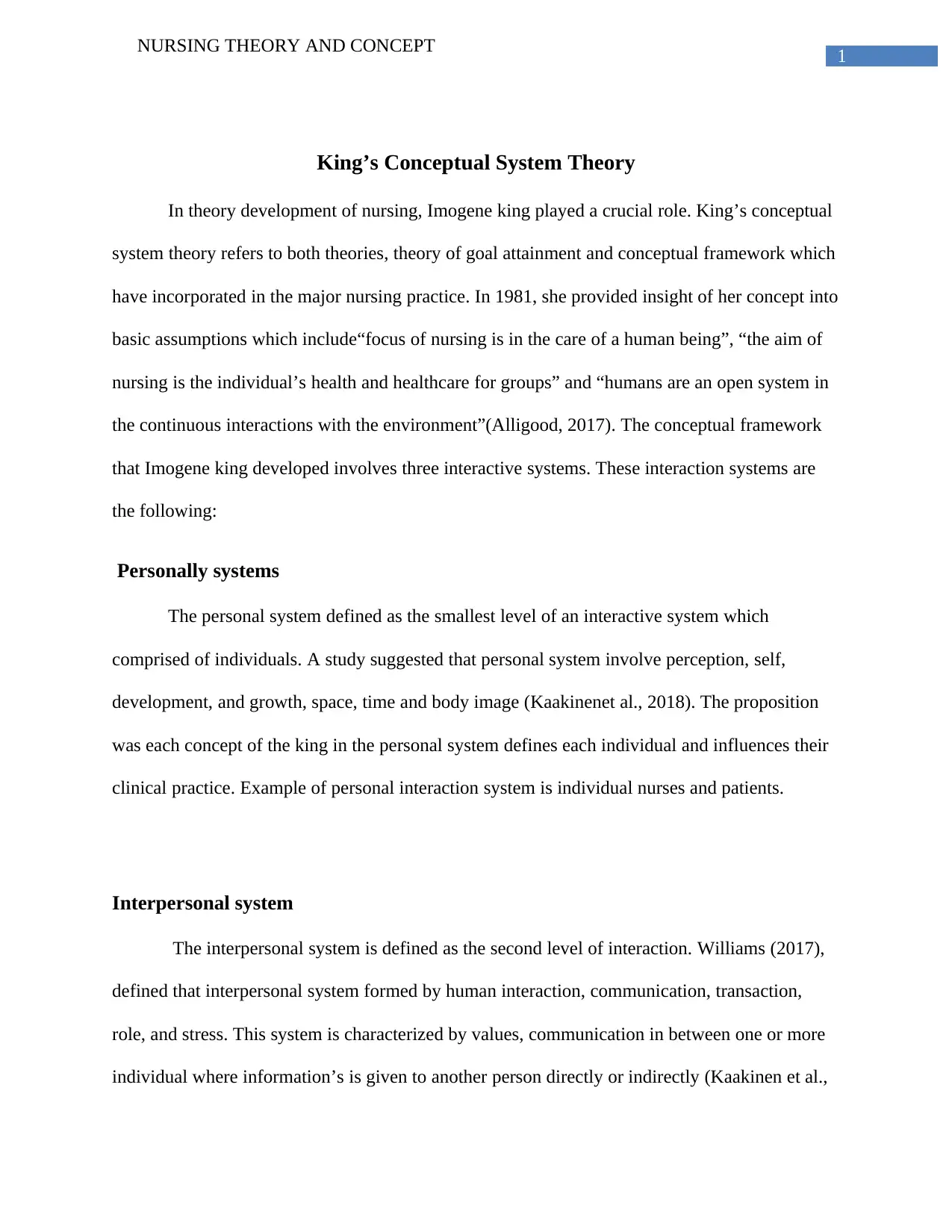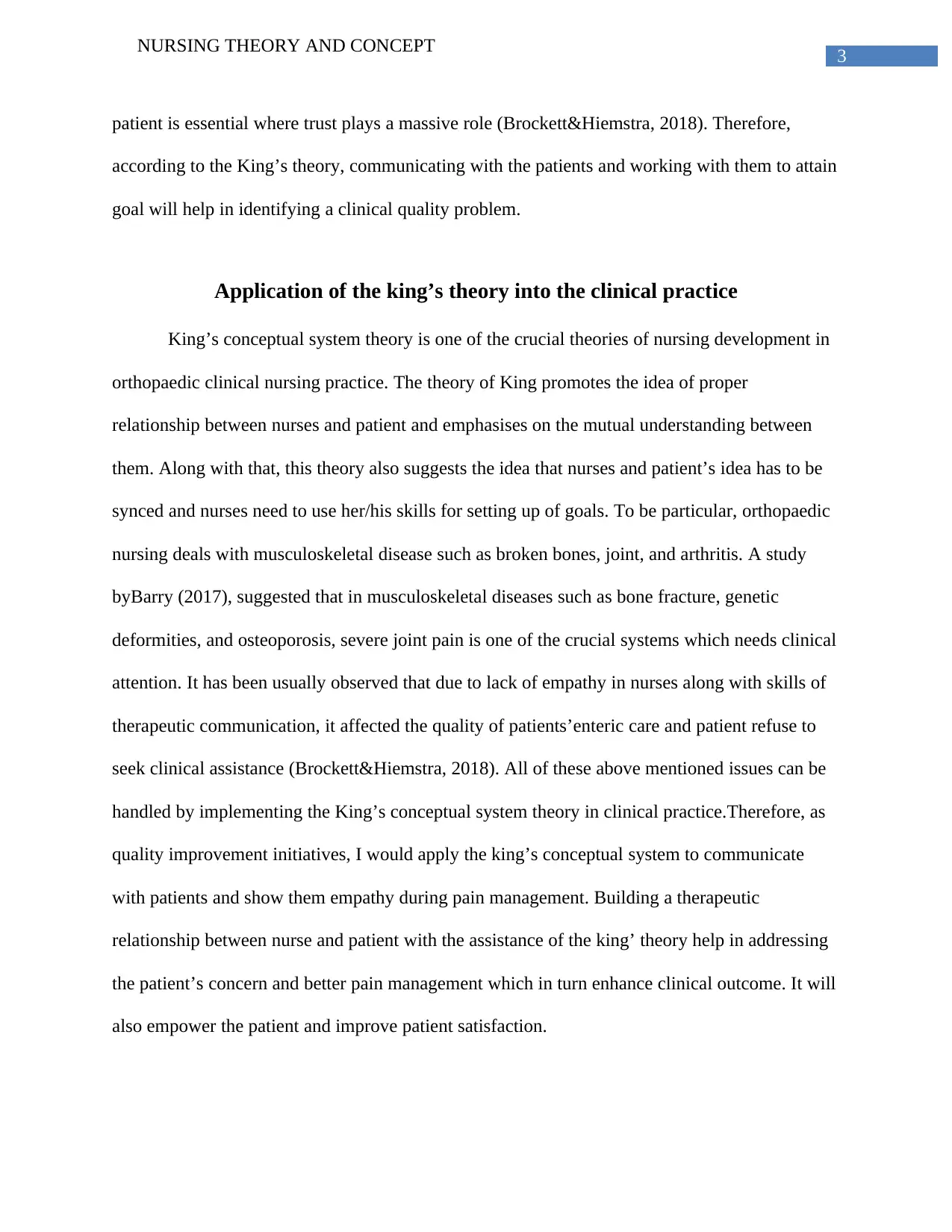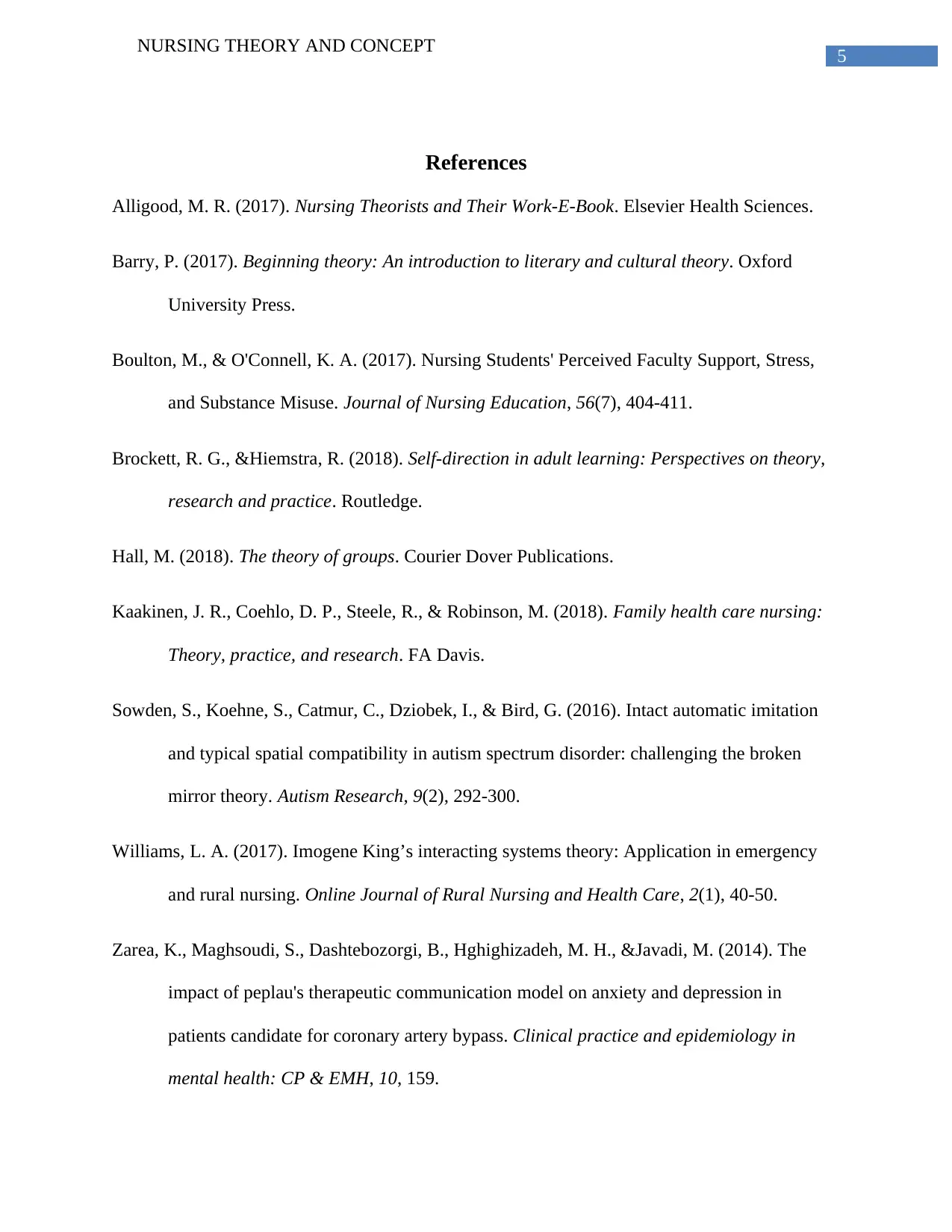Nursing Theory and Concept: King's Theory in Orthopedics
VerifiedAdded on 2023/04/20
|6
|1501
|380
Essay
AI Summary
This essay provides an in-depth analysis of Imogene King's conceptual system theory within the context of nursing practice, particularly in the field of orthopedics. It begins by outlining King's core assumptions and the three interactive systems: personal, interpersonal, and social. The essay explains how these systems influence goal attainment for both nurses and patients, emphasizing the importance of communication and therapeutic relationships. It then discusses how King's theory can identify and address clinical quality problems, especially in pain management within orthopedic nursing. The application of the theory is examined, highlighting its benefits in improving patient satisfaction and clinical outcomes. The essay concludes by aligning King’s theory with quality committee outcomes and comparing it with Peplau's Patient–Nurse Relationship theory, reinforcing the significance of patient-centered care.

Running head: NURSING THEORY AND CONCEPT
Nursing theory and concept
Name of the student:
Name of the university:
Author’s Note:
Nursing theory and concept
Name of the student:
Name of the university:
Author’s Note:
Paraphrase This Document
Need a fresh take? Get an instant paraphrase of this document with our AI Paraphraser

1
NURSING THEORY AND CONCEPT
King’s Conceptual System Theory
In theory development of nursing, Imogene king played a crucial role. King’s conceptual
system theory refers to both theories, theory of goal attainment and conceptual framework which
have incorporated in the major nursing practice. In 1981, she provided insight of her concept into
basic assumptions which include“focus of nursing is in the care of a human being”, “the aim of
nursing is the individual’s health and healthcare for groups” and “humans are an open system in
the continuous interactions with the environment”(Alligood, 2017). The conceptual framework
that Imogene king developed involves three interactive systems. These interaction systems are
the following:
Personally systems
The personal system defined as the smallest level of an interactive system which
comprised of individuals. A study suggested that personal system involve perception, self,
development, and growth, space, time and body image (Kaakinenet al., 2018). The proposition
was each concept of the king in the personal system defines each individual and influences their
clinical practice. Example of personal interaction system is individual nurses and patients.
Interpersonal system
The interpersonal system is defined as the second level of interaction. Williams (2017),
defined that interpersonal system formed by human interaction, communication, transaction,
role, and stress. This system is characterized by values, communication in between one or more
individual where information’s is given to another person directly or indirectly (Kaakinen et al.,
NURSING THEORY AND CONCEPT
King’s Conceptual System Theory
In theory development of nursing, Imogene king played a crucial role. King’s conceptual
system theory refers to both theories, theory of goal attainment and conceptual framework which
have incorporated in the major nursing practice. In 1981, she provided insight of her concept into
basic assumptions which include“focus of nursing is in the care of a human being”, “the aim of
nursing is the individual’s health and healthcare for groups” and “humans are an open system in
the continuous interactions with the environment”(Alligood, 2017). The conceptual framework
that Imogene king developed involves three interactive systems. These interaction systems are
the following:
Personally systems
The personal system defined as the smallest level of an interactive system which
comprised of individuals. A study suggested that personal system involve perception, self,
development, and growth, space, time and body image (Kaakinenet al., 2018). The proposition
was each concept of the king in the personal system defines each individual and influences their
clinical practice. Example of personal interaction system is individual nurses and patients.
Interpersonal system
The interpersonal system is defined as the second level of interaction. Williams (2017),
defined that interpersonal system formed by human interaction, communication, transaction,
role, and stress. This system is characterized by values, communication in between one or more
individual where information’s is given to another person directly or indirectly (Kaakinen et al.,

2
NURSING THEORY AND CONCEPT
2018).The example of the interpersonal system is a family where a nurse and patient interact as
well as family members interact.
Social system
The social system is defined as the largest level of a system or society. The social system
comprises ofauthority, status, organization, decision making, and power. The social interactive
system is driven by an individual’s position in that particular social system. (Alligood, 2017).
The examples of the social interactive system are religious organizations, hospitals or any other
big organizations.
Explanation of the systems influences goal attainment
Nurses have certain goals for themselves and for the patient. These three system aids in
influence the goal by building dynamic, interspersion and social relationship in which a patient
grows and develops to attain a certain goal of life.Williams (2017),stated that a perceptual
interaction that present between nurse and patient which is a part of personal system, help in
building the communication between nurse and patient along with family members. The
communication will empower patient and aid in setting goals related to health and
accomplishment of it with the assistance of the organization (Boulton& O'Connell, 2017).
King’s theory with regard to problem in clinical quality
King’s theory challenges nurses to continually educate themselves according to
requirement and identify clinical problem through evidence-based practice (Williams, 2017).
King’s theory highlighted that in order to serve patient communication of the nurses with the
NURSING THEORY AND CONCEPT
2018).The example of the interpersonal system is a family where a nurse and patient interact as
well as family members interact.
Social system
The social system is defined as the largest level of a system or society. The social system
comprises ofauthority, status, organization, decision making, and power. The social interactive
system is driven by an individual’s position in that particular social system. (Alligood, 2017).
The examples of the social interactive system are religious organizations, hospitals or any other
big organizations.
Explanation of the systems influences goal attainment
Nurses have certain goals for themselves and for the patient. These three system aids in
influence the goal by building dynamic, interspersion and social relationship in which a patient
grows and develops to attain a certain goal of life.Williams (2017),stated that a perceptual
interaction that present between nurse and patient which is a part of personal system, help in
building the communication between nurse and patient along with family members. The
communication will empower patient and aid in setting goals related to health and
accomplishment of it with the assistance of the organization (Boulton& O'Connell, 2017).
King’s theory with regard to problem in clinical quality
King’s theory challenges nurses to continually educate themselves according to
requirement and identify clinical problem through evidence-based practice (Williams, 2017).
King’s theory highlighted that in order to serve patient communication of the nurses with the
⊘ This is a preview!⊘
Do you want full access?
Subscribe today to unlock all pages.

Trusted by 1+ million students worldwide

3
NURSING THEORY AND CONCEPT
patient is essential where trust plays a massive role (Brockett&Hiemstra, 2018). Therefore,
according to the King’s theory, communicating with the patients and working with them to attain
goal will help in identifying a clinical quality problem.
Application of the king’s theory into the clinical practice
King’s conceptual system theory is one of the crucial theories of nursing development in
orthopaedic clinical nursing practice. The theory of King promotes the idea of proper
relationship between nurses and patient and emphasises on the mutual understanding between
them. Along with that, this theory also suggests the idea that nurses and patient’s idea has to be
synced and nurses need to use her/his skills for setting up of goals. To be particular, orthopaedic
nursing deals with musculoskeletal disease such as broken bones, joint, and arthritis. A study
byBarry (2017), suggested that in musculoskeletal diseases such as bone fracture, genetic
deformities, and osteoporosis, severe joint pain is one of the crucial systems which needs clinical
attention. It has been usually observed that due to lack of empathy in nurses along with skills of
therapeutic communication, it affected the quality of patients’enteric care and patient refuse to
seek clinical assistance (Brockett&Hiemstra, 2018). All of these above mentioned issues can be
handled by implementing the King’s conceptual system theory in clinical practice.Therefore, as
quality improvement initiatives, I would apply the king’s conceptual system to communicate
with patients and show them empathy during pain management. Building a therapeutic
relationship between nurse and patient with the assistance of the king’ theory help in addressing
the patient’s concern and better pain management which in turn enhance clinical outcome. It will
also empower the patient and improve patient satisfaction.
NURSING THEORY AND CONCEPT
patient is essential where trust plays a massive role (Brockett&Hiemstra, 2018). Therefore,
according to the King’s theory, communicating with the patients and working with them to attain
goal will help in identifying a clinical quality problem.
Application of the king’s theory into the clinical practice
King’s conceptual system theory is one of the crucial theories of nursing development in
orthopaedic clinical nursing practice. The theory of King promotes the idea of proper
relationship between nurses and patient and emphasises on the mutual understanding between
them. Along with that, this theory also suggests the idea that nurses and patient’s idea has to be
synced and nurses need to use her/his skills for setting up of goals. To be particular, orthopaedic
nursing deals with musculoskeletal disease such as broken bones, joint, and arthritis. A study
byBarry (2017), suggested that in musculoskeletal diseases such as bone fracture, genetic
deformities, and osteoporosis, severe joint pain is one of the crucial systems which needs clinical
attention. It has been usually observed that due to lack of empathy in nurses along with skills of
therapeutic communication, it affected the quality of patients’enteric care and patient refuse to
seek clinical assistance (Brockett&Hiemstra, 2018). All of these above mentioned issues can be
handled by implementing the King’s conceptual system theory in clinical practice.Therefore, as
quality improvement initiatives, I would apply the king’s conceptual system to communicate
with patients and show them empathy during pain management. Building a therapeutic
relationship between nurse and patient with the assistance of the king’ theory help in addressing
the patient’s concern and better pain management which in turn enhance clinical outcome. It will
also empower the patient and improve patient satisfaction.
Paraphrase This Document
Need a fresh take? Get an instant paraphrase of this document with our AI Paraphraser

4
NURSING THEORY AND CONCEPT
Alignment of King’s Conceptual System Theory with regards to quality
committee outcomes
All of the quality committee members have to be able to communicate on regular basis in
order to settle in the present intervention of patient-centric care where the leadership quality of
each member must be reflected. Any disagreement must be resolved through discussion and
information must be provided to every layer of the health care system for meeting patient’s
criteria and to achieve the designed outcome (Hall, 2018). The quality committee members
should be involved in the patient-centric care and their input would be utilized for any changes.
In this way, alignment of the King’s Conceptual System Theory can be achieved in regards with
quality committee outcomes.
Additional nursing theory
King’s conceptual system theory is in alignment with the Peplau's Patient – Nurse
Relationship. The rationale behind choosing the Peplau's Patient theory is that the importance of
construction a credulous relationship between patient and nurse is highlighted in the both
theories and both the theories aid in designing process of a care plan for patient. Peplau's theory
defined nursing as a therapeutic and interpersonal process which takes place when professionals
involve themselves in the therapeutic relationship with the patient (Brockett&Hiemstra, 2018).
Therefore, to conclude, both the theories suggested that one must be open-minded and able to
adapt to the changes in order to provide patient-centric care.
NURSING THEORY AND CONCEPT
Alignment of King’s Conceptual System Theory with regards to quality
committee outcomes
All of the quality committee members have to be able to communicate on regular basis in
order to settle in the present intervention of patient-centric care where the leadership quality of
each member must be reflected. Any disagreement must be resolved through discussion and
information must be provided to every layer of the health care system for meeting patient’s
criteria and to achieve the designed outcome (Hall, 2018). The quality committee members
should be involved in the patient-centric care and their input would be utilized for any changes.
In this way, alignment of the King’s Conceptual System Theory can be achieved in regards with
quality committee outcomes.
Additional nursing theory
King’s conceptual system theory is in alignment with the Peplau's Patient – Nurse
Relationship. The rationale behind choosing the Peplau's Patient theory is that the importance of
construction a credulous relationship between patient and nurse is highlighted in the both
theories and both the theories aid in designing process of a care plan for patient. Peplau's theory
defined nursing as a therapeutic and interpersonal process which takes place when professionals
involve themselves in the therapeutic relationship with the patient (Brockett&Hiemstra, 2018).
Therefore, to conclude, both the theories suggested that one must be open-minded and able to
adapt to the changes in order to provide patient-centric care.

5
NURSING THEORY AND CONCEPT
References
Alligood, M. R. (2017). Nursing Theorists and Their Work-E-Book. Elsevier Health Sciences.
Barry, P. (2017). Beginning theory: An introduction to literary and cultural theory. Oxford
University Press.
Boulton, M., & O'Connell, K. A. (2017). Nursing Students' Perceived Faculty Support, Stress,
and Substance Misuse. Journal of Nursing Education, 56(7), 404-411.
Brockett, R. G., &Hiemstra, R. (2018). Self-direction in adult learning: Perspectives on theory,
research and practice. Routledge.
Hall, M. (2018). The theory of groups. Courier Dover Publications.
Kaakinen, J. R., Coehlo, D. P., Steele, R., & Robinson, M. (2018). Family health care nursing:
Theory, practice, and research. FA Davis.
Sowden, S., Koehne, S., Catmur, C., Dziobek, I., & Bird, G. (2016). Intact automatic imitation
and typical spatial compatibility in autism spectrum disorder: challenging the broken
mirror theory. Autism Research, 9(2), 292-300.
Williams, L. A. (2017). Imogene King’s interacting systems theory: Application in emergency
and rural nursing. Online Journal of Rural Nursing and Health Care, 2(1), 40-50.
Zarea, K., Maghsoudi, S., Dashtebozorgi, B., Hghighizadeh, M. H., &Javadi, M. (2014). The
impact of peplau's therapeutic communication model on anxiety and depression in
patients candidate for coronary artery bypass. Clinical practice and epidemiology in
mental health: CP & EMH, 10, 159.
NURSING THEORY AND CONCEPT
References
Alligood, M. R. (2017). Nursing Theorists and Their Work-E-Book. Elsevier Health Sciences.
Barry, P. (2017). Beginning theory: An introduction to literary and cultural theory. Oxford
University Press.
Boulton, M., & O'Connell, K. A. (2017). Nursing Students' Perceived Faculty Support, Stress,
and Substance Misuse. Journal of Nursing Education, 56(7), 404-411.
Brockett, R. G., &Hiemstra, R. (2018). Self-direction in adult learning: Perspectives on theory,
research and practice. Routledge.
Hall, M. (2018). The theory of groups. Courier Dover Publications.
Kaakinen, J. R., Coehlo, D. P., Steele, R., & Robinson, M. (2018). Family health care nursing:
Theory, practice, and research. FA Davis.
Sowden, S., Koehne, S., Catmur, C., Dziobek, I., & Bird, G. (2016). Intact automatic imitation
and typical spatial compatibility in autism spectrum disorder: challenging the broken
mirror theory. Autism Research, 9(2), 292-300.
Williams, L. A. (2017). Imogene King’s interacting systems theory: Application in emergency
and rural nursing. Online Journal of Rural Nursing and Health Care, 2(1), 40-50.
Zarea, K., Maghsoudi, S., Dashtebozorgi, B., Hghighizadeh, M. H., &Javadi, M. (2014). The
impact of peplau's therapeutic communication model on anxiety and depression in
patients candidate for coronary artery bypass. Clinical practice and epidemiology in
mental health: CP & EMH, 10, 159.
⊘ This is a preview!⊘
Do you want full access?
Subscribe today to unlock all pages.

Trusted by 1+ million students worldwide
1 out of 6
Related Documents
Your All-in-One AI-Powered Toolkit for Academic Success.
+13062052269
info@desklib.com
Available 24*7 on WhatsApp / Email
![[object Object]](/_next/static/media/star-bottom.7253800d.svg)
Unlock your academic potential
Copyright © 2020–2025 A2Z Services. All Rights Reserved. Developed and managed by ZUCOL.





